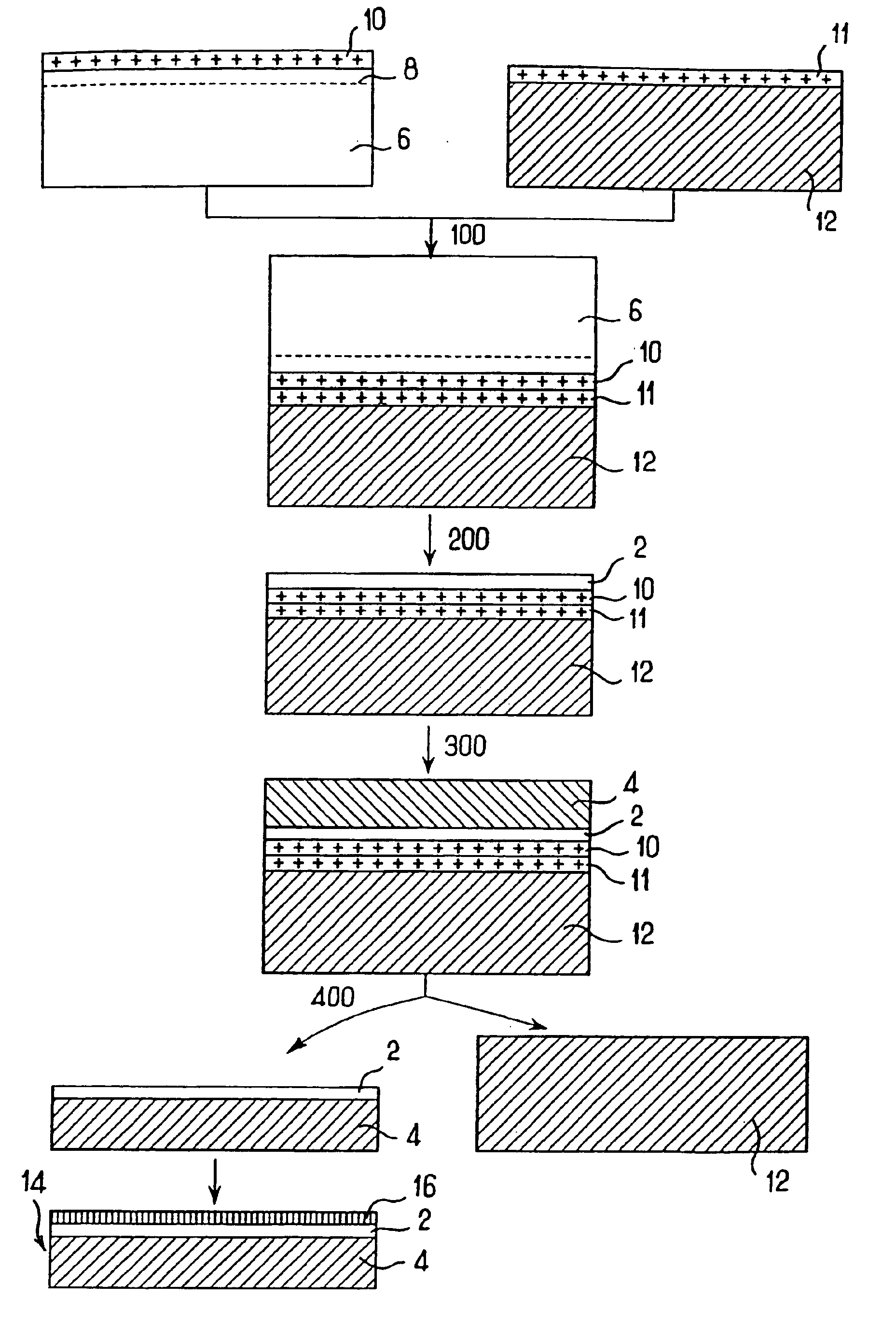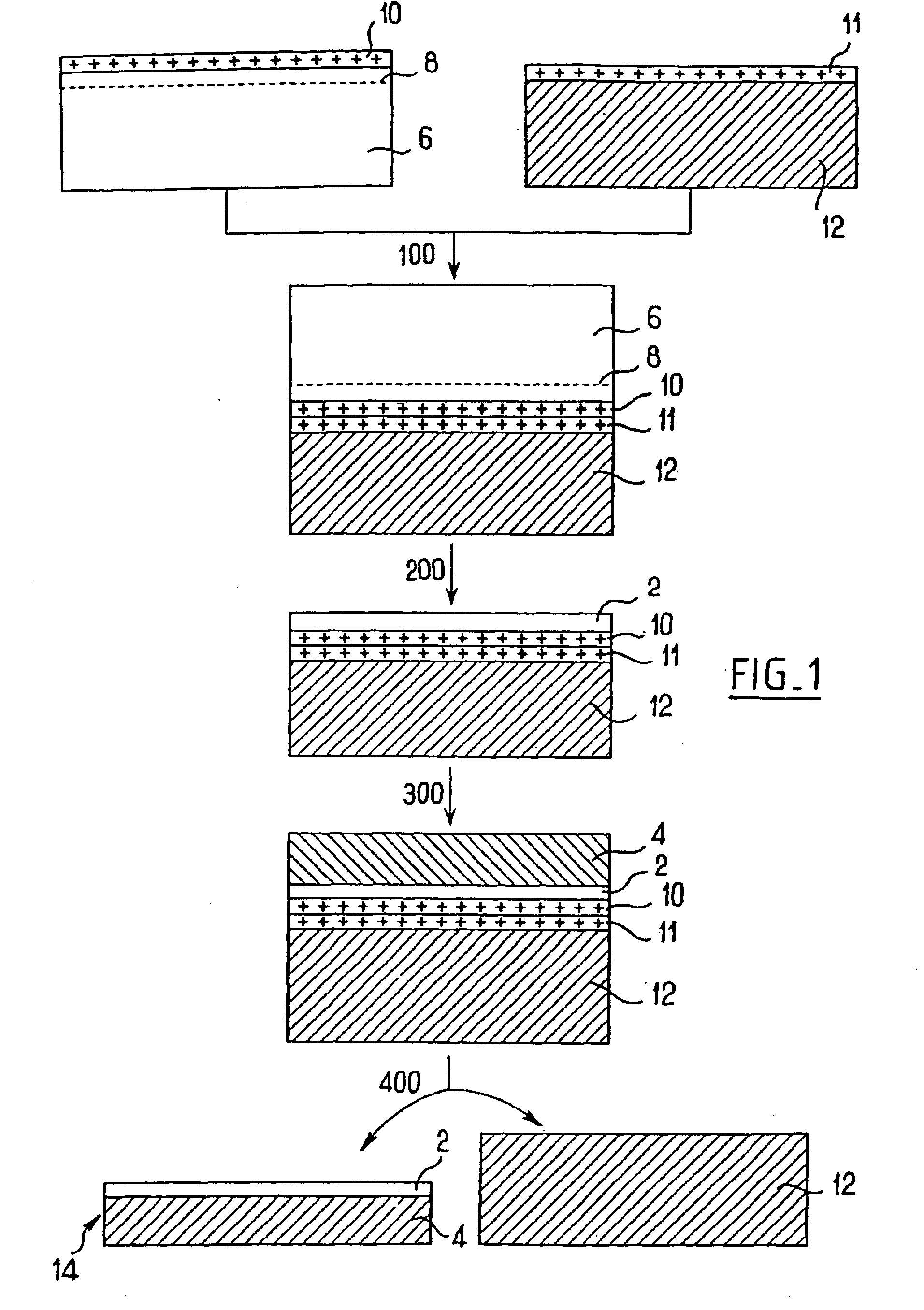Methods for fabricating final substrates
a technology of final substrates and substrates, applied in the direction of thin material processing, electrical equipment, semiconductor devices, etc., can solve the problems of relative longness and complexity
- Summary
- Abstract
- Description
- Claims
- Application Information
AI Technical Summary
Benefits of technology
Problems solved by technology
Method used
Image
Examples
first embodiment
A number of non-limiting examples are now presented. The following table summarizes examples of materials that can be used for implementing the first embodiment described above.
TABLE 1IntermediateSupporting thickBonding layersThin layer 2support 12layer 410, 11Mono SiCPoly SiC orPoly SiC or polySiO2 or Si3N4mono SiCAlN or diamondor mono SiC ofquality inferior tothat of the thinlayerMono GaNPoly SiC or monoPoly SiC or polySiO2or Si3N4SiC or sapphireAlN or poly GaNor diamond ormono SiC ofquality inferior tothat of the thinlayer{111}, {1000}Poly Si or monoPoly Si or monoSiO2 or Si3N4etc. mono SiSi or poly SiC orSi of qualitymono SiCinferior to that ofthe thin layer
In the above table, as in the following tables, the term “mono” means “monocrystalline” and the term “poly” means “polycrystalline”.
example 1
The first example corresponds to the first row of Table 1.
The first implementation is particularly advantageous for forming a substrate comprising a thin transfer layer 2 of monocrystalline silicon carbide on a thick support material layer 4 of polycrystalline silicon carbide. Silicon carbide is difficult to obtain in single crystal form, even with diameters that are much smaller than those which are commonly obtained for single silicon crystals. This is due in particular to the fact that crystal-drawing techniques are more complex and expensive for monocrystalline silicon carbide than for monocrystalline silicon. In addition, the substrate forming steps are more difficult, more time consuming, and more expensive, for monocrystalline silicon carbide because of the unfavorable ratio between the hardness and the brittleness of silicon carbide. The present method is thus particularly advantageous for fabricating substrates with thin transfer layers 2 of silicon carbide since it enables...
example 2
This second example corresponds to the second line of Table 1, and comprises the steps shown in FIG. 2. The operation includes depositing a thin layer 2 of monocrystalline gallium nitride on a source substrate 6 of monocrystalline silicon carbide by metal organic chemical vapor deposition (MOCVD) or by molecular beam epitaxy (MBE). A bonding layer 10 of silicon oxide is deposited on the thin layer 2, and a bonding layer 11 of silicon oxide is is deposited on an intermediate support 12 of polycrystalline silicon carbide. Next, in step 100, the two bonding layers 10 and 11 are placed in contact with each other, and bonded together. The method includes, in step 200, detaching the thin layer 2 of gallium nitride from the source substrate 6 via the interface between the thin transfer layer 2 and the source substrate 6 (e.g. by applying mechanical stresses) or via a zone of weakness made, for example, by implanting atomic species in the monocrystalline silicon carbide of the source substr...
PUM
| Property | Measurement | Unit |
|---|---|---|
| temperatures | aaaaa | aaaaa |
| temperatures | aaaaa | aaaaa |
| diameter | aaaaa | aaaaa |
Abstract
Description
Claims
Application Information
 Login to View More
Login to View More - R&D
- Intellectual Property
- Life Sciences
- Materials
- Tech Scout
- Unparalleled Data Quality
- Higher Quality Content
- 60% Fewer Hallucinations
Browse by: Latest US Patents, China's latest patents, Technical Efficacy Thesaurus, Application Domain, Technology Topic, Popular Technical Reports.
© 2025 PatSnap. All rights reserved.Legal|Privacy policy|Modern Slavery Act Transparency Statement|Sitemap|About US| Contact US: help@patsnap.com



